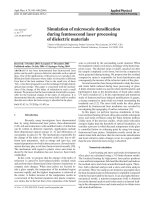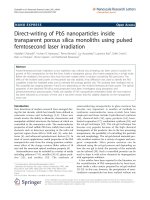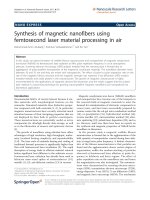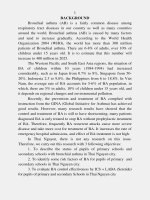3 dimenstional microstructural fabrication of foturanTM glass with femtosecond laser irradiation
Bạn đang xem bản rút gọn của tài liệu. Xem và tải ngay bản đầy đủ của tài liệu tại đây (1.9 MB, 147 trang )
3-DIMENSIONAL MICROSTRUCTURAL
FABRICATION OF FOTURAN
TM
GLASS WITH
FEMTOSECOND LASER IRRADIATION
TEO HONG HAI
NATIONAL UNIVERSITY OF SINGAPORE
2009
3-DIMENSTIONAL MICROSTRUCTURAL
FABRICATION OF FOTURAN
TM
GLASS WITH
FEMTOSECOND LASER IRRADIATION
TEO HONG HAI
(B. Eng. (Hons.), Nanyang Technological University)
A THESIS SUBMITTED
FOR THE DEGREE OF MASTER OF ENGINEERING
DEPARTMENT OF ELECTRICAL AND
COMPUTER ENGINEERING
NATIONAL UNIVERSITY OF SINGAPORE
2009
Acknowledgement
i
ACKNOWLEDGEMENTS
I would like to take this opportunity to express my appreciation to my supervisor,
Associate Professor Hong Minghui for his guidance during the entire period of my
Masters studies. He has been encouraging particularly in trying times. His suggestions
and advice were very much valued.
I would also like to express my gratitude to all my fellow co-workers from the DSI-NUS
Laser Microprocessing Lab for all the assistance rendered in one way or another.
Particularly to Caihong, Tang Min and Zaichun for all their encouragement and
assistance as well as to Huilin for her support in logistic and administrative issues.
Special thanks to my fellow colleagues from Data Storage Institute (DSI), in particular,
Doris, Kay Siang, Zhiqiang and Chin Seong for all their support.
To my family members for their constant and unconditioned love and support throughout
these times, without which, I will not be who I am today.
TableofContents
ii
TABLE OF CONTENTS
ACKNOWLEDGEMENTS
i
TABLE OF CONTENTS
ii
SUMMARY
v
LIST OF FIGURES
viii
LIST OF SYMBOLS
x
LIST OF PUBLICATIONS
xi
CHAPTER 1 INTRODUCTION
1.1 General Background 1
1.2 Recent Progress in Photosensitive Glass and Femtosecond Laser
Microprocessing
2
1.3 Limitations of Conventional Glass and Challenges on Laser Microprocessing
Techniques of Glass Substrates
9
1.4 Fabrication by Femtosecond Laser on Foturan
TM
Glass 12
1.5 Research Objectives and Contributions 17
1.5.1 Fabrication of a Monolithic 2-level 3-dimensional Micro-mixer 17
1.5.2 Optimization of a Monolithic 2-level 3-dimensional Micro-mixer 18
1.6 Thesis Outline 20
TableofContents
iii
CHAPTER 2 THEORETICAL BACKGROUND
2.1 Multi-photon Absorption by Photosensitive Glass 27
2.1.1 Photosensitive Glass under Femtosecond Laser Irradiation 31
2.2 Mechanism during Thermal Annealing of Photosensitive Glass under
Femtosecond Laser Irradiation
35
2.2.1 Reactions Involved during Thermal Annealing of Foturan
TM
Glass
after Laser Exposure
35
2.3 Chemical Reactions during Wet Chemical HF etching of Photosensitive
Glass under Femtosecond Laser Irradiation
38
CHAPTER 3 EXPERIMENTAL SETUP
3.1 Femtosecond Laser Fabrication of Microstructures In-situ of Foturan
TM
Glass
44
3.1.1 Introduction 44
3.1.2 Experimental Setup of Femtosecond Laser Irradiation of Foturan
TM
Glass
46
3.1.3 Application of the Femtosecond Laser 48
3.1.4 Thermal Annealing Cycle and Wet Chemical Etching 50
3.2 Characterization Techniques for the Monolithic 2-level 3D Internal Micro-
mixer
51
3.2.1 Optical Microscopy 51
3.2.2 JEOL JSM 7401F Scanning Electron Microscopy (SEM) 54
3.2.3 3D Surface Profilometry 56
3.2.5 Characterizing the Mixing Capability of the Fabricated Micro-mixer 58
TableofContents
iv
CHAPTER 4 3-DIMENSIONAL MICROSTRUCTURAL FABRICATION BY
FEMTOSECOND LASER MICROPROCESSING
4.1 Fabrication Process Flow 62
4.1.1 Sample Preparation 64
4.1.2 Multi-Photon Absorption 66
4.1.3 Principles of Two-Photon Excitation 69
4.2 Thermal Annealing 71
4.3 Etching 72
4.3.1 Isotropy / Anisotropy 77
4.3.2 Selectivity 79
4.4 Characterizing the 2-level 3D Internal Micro-mixer 79
CHAPTER 5 RESULTS AND DISCUSSION
5.1 Introduction 88
5.2 Influence of Laser Irradiation 91
5.3 Influence of Thermal Cycling 99
5.4 Influence of Wet Chemical Etching 102
5.5 Design Optimization 104
CHAPTER 6 CONCLUSIONS
6.1 Conclusions 112
6.2 Suggestions for Future Work 115
Summary
v
SUMMARY
Fabrication of real 3-dimensional (3D) microstructures embedded inside a monolithic
Foturan
TM
glass is a very attractive and promising technology in the field of life sciences
and biotechnology. It offers a wide range of opportunities and opens up many potential
applications in the studies of photonics, medicine as well as aerospace engineering. This
technique exploits the unique optical, chemical and physical properties of
microstructuring inside glass.
The research reported in this thesis primarily aims to fabricate real 3D microstructures,
achieves multiple micro-channels and multi-level connectivity as well as to investigate
the process optimization by making use of different methods and varying different
parameters. Currently, the difficulties of fabricating microstructures inside glass are
evident in the wide variety of non-conventional techniques employed. The most
commonly used approach in glass patterning is based on conventional lithography,
however, this technique is limited by slow etch rates with majority of the patterning
performed on the surfaces of the samples. Micro-cracking and other collateral damages
further introduce additional unnecessary stresses to the glass substrates. In addition, this
approach has many limitations in numerous industrial applications attributing from the
high cost of the masks, low throughput and the many tedious repeating steps.
Therefore, our direct laser application, a fast and maskless technique, has been used in
this thesis for the patterning and fabrication of micro-architectures and microstructures
Summary
vi
inside the photosensitive glass, Foturan
TM
. This technique involves only a femtosecond
laser and a 3 axes X-Y-Z stage. Its main advantages lie in its low cost, high speed and
being a simple operation. After the patterns are formed inside the Foturan
TM
glass, a
thermal annealing cycle will follow and subsequent etching is employed to fabricate the
required design of the microstructures. The utilization of femtosecond laser irradiation
employs multi-photon absorption (MPA), which permits the fabrication of embedded
intricate 3D microstructures and integrates all these complex microstructures within the
material. This technique has the capability to create undercut and freestanding
microstructures without resorting to ablation, thereby minimizing residual stresses as well
as impending issues of surface morphology. These monolithic ‘all-in-one’ devices are
highly desirable because of their potentials in meeting unique and individually
customized requirements in various applications. In this thesis, a monolithic real 3D ‘all-
in-one’ analytical device with 2 levels of micro-reservoirs and interconnecting micro-
channels was fabricated. The mixing capability of the device is demonstrated by mixing
individual colored dyes to obtain a single homogeneous dye solution. The repeatability
and reliability of the fabricated device were further demonstrated with further mixing of
other dyes. Since Foturan
TM
glass is highly sensitive to the dosage of irradiation,
exposure time, annealing temperature and time, etching concentration and time, the
desired embedded microstructures have been achieved by varying these parameters.
Different approaches were undertaken in order to optimize the mixing capability of the
monolithic 2-level 3D embedded micro-mixer. First and foremost, the laser irradiation
power was investigated and determined to eradicate the issue of surface ablation, an issue
Summary
vii
experienced by most international research groups. Subsequent process of thermal
annealing time and temperature were further optimized to initiate the photo-chemical
reaction. Insufficient heating does not initiate the nucleation and agglomeration process
while extended heating will result in the warpage of the Foturan
TM
glass, which has a
major detrimental effect towards the etching process. The etching times were also
affected by the internal surface roughness of the microstructures. This in turn is
determined by the geometries of the microstructures as well as gravity-assisted reactions.
In conclusion, a monolithic real 3D microstructure has been fabricated by a simple
process of direct maskless laser processing capable of customization for various unique
requirements in different applications. Several approaches were undertaken in
optimizing the fabrication process and maintaining the functionality and structural
integrity of the device. This enables the successful demonstration of the mixing capability
of the micro-mixer. Detailed mechanism is also carefully investigated in this thesis.
ListofFigures
viii
LIST OF FIGURES
Fig. 2.1. Structure of the monolithic 2-level 3D micro-mixer: (a) micro-mixer
fabricated inside Foturan
TM
glass by femtosecond laser, (b) micro-mixer after
thermal annealing cycle and (c) 3D micro-mixer after the final etching process.
37
Fig. 3.1. Experimental setup for the femtosecond laser irradiation of Foturan
TM
glass.
46
Fig. 3.2. (a) Setup of the irradiation process, comprising of the femtosecond laser
together with the optical setup as well as the 3 axes stage. Red arrows depict the
path of the laser. (b) and (c) Closed up views of the magnifying lens and 3 axes
stage.
47
Fig. 3.3. Design of the microsctructure within the Foturan
TM
samples from 4
different viewing angles; (a) Top view. (b) Isometric view. (a) Front view. (b) Side
view.
49
Figure 3.4. HP4284A Precision LCR Meter Dielectric Tester oven employed in the
2-stage annealing process.
50
Figure 3.5. Olympus MX-50 optical microscope with magnification lens of 10, 20,
50, 80, 100 and 150.
52
Figure 3.6. Magnification module of the Olympus MX-50 optical microscope.
53
Figure 3.7. JEOL JSM 7401F.
54
Figure 3.8. Mitutoyo Surftest Extreme SV-3000CNC 3D surface profiler.
56
Fig. 3.10. (a) Structure of the fabricated monolithic 2-level 3D micro-mixer. (b)
Mixing of the yellow and blue dyes in the central micro-reservoir resulting in a
green dye solution. (c) Mixing of the yellow and pink dyes.
59
ListofFigures
ix
Fig. 4.1. Flow chart of the 2-level 3D micro-mixer fabrication process.
63
Fig. 4.2. Design of the microstructure within the Foturan
TM
samples from 4
different viewing angles; (a) Top view. (b) Isometric view. (a) Front view. (b) Side
view.
65
Fig. 4.3. 2-photon absorption of Cesium.
68
Fig. 4.4. Two-photon Jablonski Energy Diagram.
68
Fig. 4.5. Temperature-time plot of the annealing cycle.
71
Fig. 4.6. Typical parallel-plate reactive ion etching system.
76
Fig. 4.7. Difference between anisotropic and isotropic wet etching.
78
Fig. 4.8. (a) Optical images of the entrance of yellow dye through the right inlet. (b)
Entrance of blue dye through the left inlet. (c) Cross-sectional view of the mixing
process for the blue and yellow dyes. (d) Onset of mixing between the yellow and
blue dyes.
81
Fig. 4.8. (e) Closed-up view of the sample during the mixing process. (f) Closed-up
on the mixing process within the micro-reservoir. (g) Mixing process of the yellow
and pink dyes. (h) Cross-sectional view during mixing of the yellow and pink dyes.
82
Fig. 4.9. (a) to (n) Sequence of events during the mixing process. (o) A close up
view of the mixing within the central micro-reservoir.
85
Fig. 5.1. Etch rate ratios vs. laser irradiance for (a) λ = 266 nm and (b) λ = 355 nm.
The etch rate ratios are represented by the solid squares.
96
Listofsymbols
x
LIST OF SYMBOLS
λ Wavelength
h Planck's constant (6.626068 × 10
-34
m
2
kg / s)
v Frequency
e
-
Electron
H Enthalpy
E Energy
l Angular momentum
t Time
g Local acceleration due to gravity (9.81 m / s
2
)
ListofPublications
xi
LIST OF PUBLICATIONS
1. H. H. Teo
and M. H. Hong, A Monolithic 2-level 3-Dimensional Micro-mixer
Fabrication by Femtosecond Laser and its Characterization, 5
th
International Congress
on Laser Advanced Materials Processing.
2. H. H. Teo, M. H. Hong, L.P. Shi and T.C. Chong, Optical Diagnostics of
Femtosecond Laser Processing of Foturan Glass, 10
th
International Conference on
Laser Ablation. (Abstract submitted)
3. P. B. Phua, W. J. Lai, Y. L. Lim, K. S. Tiaw, B. C. Lim, H. H. Teo, and M. H. Hong,
" Mimicking optical activity for generating radially polarized light," Optics Letters,
Vol. 32, p 376-378, 2007
4. W. J. Lai, B. C. Lim, P. B. Phua, K. S. Tiaw, H. H. Teo
, and M. H. Hong, Generation
of radially polarized beam with a segmented spiral varying retarder, Optics Express,
Vol. 16, Issue 20, pp. 15694-15699 (2008)
5. H.L. Seet, X.P. Li, M.H. Hong, K.S. Lee, K.H. Teh and H.H. Teo
, Electrodeposition
of Ni–Fe micro-pillars using laser drilled templates, Journal of Materials Processing
Technology, Volumes 192-193, 1 October 2007, Pages 346-349
Chapter1Introduction
1
CHAPTER 1
INTRODUCTION
1.1 General Background
Glass ceramic (GC) materials have a distinguished history in numerous industrial,
commercial, and scientific disciplines and are widely employed in a broad spectrum of
applications. GC materials are a unique class of material that combines the special
properties of sintered ceramics with the characteristics of glasses and represents an
important technological capability in various applications, such as aerospace engineering
[1], optics, photonics [2], biology, biochemistry [3], computer technology [4] and
commercial architecture [5]. This diverse array of applications is attributed to the
attractive and versatile chemical and physical properties of these glass ceramics, such as
corrosion resistance, high temperature stability, optical transparency and
biocompatibility. GC materials can be further synthesized to be virtually defect-free with
no porosity [4]. They can be optically transparent or opaline, and can also be designed for
applications requiring limited shrinkage and electronic- and bio-compatible [4]. By
altering the chemical compositions within the GC materials, the optical, mechanical and
electrical properties of glass ceramics can also be further tailored to meet a wider and
more diverse set of application requirements.
Chapter1Introduction
2
1.2 Recent Progress in Photosensitive Glass and Femtosecond Laser
Microprocessing
The first commercially viable glass ceramics were utilized in the aerospace industry to
fabricate radomes (radar domes) that shielded sensitive antenna equipment in aircraft and
rocket nose cones [6]. Glass ceramics, for instance cordierites, were ideally suited for
radome technology and atmospheric re-entry issues due to their high bending strength,
low thermal expansion, and high thermal shock resistance [7]. More recently, glass
substrates have been utilized in the development and construction of micro-total-analysis-
systems (μTAS) or “lab-on-a-chip” systems [3]. These devices require complex
integration of sub-systems to facilitate efficient sample transfer, chemical separation,
control of chemical and biological reactions and species monitoring and detection. The
fabrication technology employs to manufacture the individual components that
accomplish these tasks must be versatile to realize all the required devices that contain
multiple depth structures, chemical inertness at desired locations, and surface roughness
that can be fashioned for each application. The ability to co-fabricate micro-fluidic
systems, such as valves, nozzles and channels, along with other integrated optical,
electrical, and mechanical structures either on the surface or in the interior of the glass,
has helped to realize the μTAS system as a complete analytical device that can
accomplish all phases of the sample analyses. The myriad of technological applications
that are possible with glass ceramic materials necessitate that the fabrication methods
must be able to achieve component and sub-system integration by producing functional
Chapter1Introduction
3
structures that range in the scale from the micro (< 100 μm) to the meso- (100 μm–10
mm) and to the macro-dimensional (> 10 mm) domains and beyond.
Besides silicon, glass is a widely used substrate material in micro-system technology, in
particular in the manufacture of micro-fluidic devices for biological analyses and
biotechnical applications [7] as it provides beneficial structural and functional material
properties. In comparison to silicon, the use of glass in micro-total-analysis-systems
(µTAS) applications is advantageous with regards to its optical transparency which
allows for easy instantaneous visual monitoring and real-time optical inspection and
detection due to its good fluorescence properties as well as its good dielectric properties
used in a number of applications, thereby allowing it to withstand the high voltages in
electro-kinetically driven flows and separations, particularly in capillary electrophoresis.
Other beneficial properties of glass are its good chemical resistance, high thermal
stability, chemical inertness and combined with other matured and established schemes
for surface modification and fictionalization (silane modification), make glass the most
widely used substrate in the fabrication of DNA arrays. The use of glass substrates
further improves the long term chemical stability of the devices in comparison with
silicon-based systems. Many applications also require the high mechanical strength and
the good mechanical stability of glass.
The growing needs for micro-devices with high efficiency and performance for
biochemical analyses and medical inspection drive the three-dimensional (3D) fabrication
and integration of versatile micro-components on a single chip [8]. Currently, the
Chapter1Introduction
4
development of “all-in-one” microchips in which micro-components, such as those of
fluidics, mechanics, and optics, are integrated into a single chip still pose numerous
challenges from the conceptual stage to the mass production phase [9]. In the
manufacture of micro-devices, the material selection is of utmost importance for “all-in-
one” fabrication.
This concept of lab-on-a-chip has created a revolution in chemical, biological, and
medical sciences. A lab-on-a-chip device, which is a palm sized chip, integrated with
functional components, such as micro-fluidics, micro-optics, microelectronics, and
micromechanics, offers several advantages over the traditional chemical and biological
analytical techniques [12]. Particularly its ultra-fine dimensions, the lab-on-a-chip allows
the performing of chemical and biological analyses with the ease of use, low sample and
reagent consumption, low waste production, high speed analysis, and high reproducibility
due to standardization and automation. Recently, significant progress has been made in
the incorporation of optical circuits into the fluidic circuits, which would eventually
enable enhanced functionality of the lab-on-a-chip devices. A variety of optical
structures, including optical waveguides [13], micro-optical gratings [14], optical fibers
[15], micro-optical mirrors [11], and micro-optical cylindrical lenses [16], have been used
in the construction of fluidic photonic integrated devices. The fabrication of three-
dimensional (3D) micro-optical cylindrical and hemispherical lenses vertically embedded
inside glass by a femtosecond (fs) laser micromachining system, together with micro-
optical lenses, can focus laser beams into very small and tight beam spots. This holds
great promises for numerous practical applications in life sciences.
Chapter1Introduction
5
In the “lab-on-a-chip” or micro-total-analysis-system (μ-TAS) devices used for photonic
bio-sensing, a light beam is often required to illuminate a liquid sample in a micro-fluidic
chamber to realize photo-absorption or fluorescence detection. The use of a waveguide is
a highly efficient way to guide the light to the liquid sample. The waveguide can be
connected to an optical spectrometer or photo-detector to collect the light transmitted by
or emitted from the liquid sample. Therefore, some research groups are attempting to
integrate optical waveguides with micro-fluidic components in a single chip [17]. Further
integration of micro-optical components, such as a micro-mirror and a microlens, is
expected to be able to enhance the efficiencies of inducing and / or collecting signals in
optical analyses. For this purpose, micro-mirrors have been fabricated inside Foturan
TM
glass [18]. Furthermore, the fabrication of cylindrical and hemispherical microlenses
made of Foturan
TM
glass by fs laser processing has been reported [19].
In recent years, we have witnessed a steady progress in the fabrication of micro-fluidic
structures, for example, micro-reactors for chemical analyses [10] and a number of
micro-optical structures, such as micro-fluidic dye laser [11] in a photosensitive
Foturan
TM
glass chip by femtosecond (fs) laser microprocessing. The ability to directly
fabricate 3D microstructures in Foturan
TM
glass by using the femtosecond laser, along
with its resistance to high temperature and corrosion as well as high optical transparency,
has made it a particularly attractive platform for bio-photonic micro-devices [3].
More recently, near infra-red (NIR) femtosecond lasers have been utilized for the
manufacturing of embedded 3D structures in GCs. Complex micro-fluidic channels [21],
Chapter1Introduction
6
micro-optical components [22], and compliant micro-plate structures [23] for lab-on-a-
chip applications have been formed in photo-structurable glass ceramics using
femtosecond laser irradiation at λ = 775 nm and λ = 800 nm. Some present studies are
investigating the ability to merge pulsed UV laser direct-write patterning with batch
chemical processing. The laser fabrication technique involves the controlled variation of
the laser irradiance with high precision during pattern formation in the photo-structurable
glass; we refer to this method as variable laser exposure processing [24].
Pulsed high repetition rate ultra-violet (UV) and infra-red (IR) lasers have also been
incorporated into the photo-processing of these GC materials. Using direct write
patterning techniques, where masking steps are not necessary, pulsed lasers have
permitted the fabrication of true three-dimensional (3D) microstructures, embedded
channels, and interconnected microstructures [5]. Recently, a novel UV laser processing
technique has been developed that significantly enhances the capability and versatility of
traditional materials fabrication and current laser processing. The new technique
combines the advantages of direct-write volumetric laser patterning and batch chemical
processing. The merged non-thermal laser processing approach involves the controlled
variation of the laser irradiance (mW/μm
2
) with high precision during pattern formation
in the photo-structurable glass. Variation in the laser exposure dose permits the creation
of variegated and proximal high (30 : 1) and low (< 1 : 1) aspect ratio structures on a
common substrate. These structures can be co-fabricated in a single batch chemical etch
step without the need for a complex masking sequence or a post-processing ablation step.
This novel technique facilitates rapid prototype processing, while maintaining pattern and
Chapter1Introduction
7
component uniformity and integrity, achieves material processing over large areas
without incurring high cost. Under controlled variation of the laser irradiation, this
technique also permits site-specific or “fine tuning” of other GC material properties, such
as the optical transmission, mechanical strength and compliance, and electrical
conductivity [20].
One type of GC material that is receiving significant attention is the photo-structurable or
photosensitive glass ceramic material class. The key attribute that separates these
photosensitive glass ceramic materials from the other material classes is the ability to
control the precipitation of a soluble ceramic phase from the base glass. A photo-active
compound (photo-initiator) and metal ions (nucleating agents) are added to the glass
matrix to permit local spatial control of the precipitation process [25]. This attribute
permits two-dimensional (2D) and three-dimensional (3D) micro-shaping and micro-
structuring of PSGC materials via optical lithographic patterning and chemical etching
processes; these techniques are analogous to the processing of photo-resist and SU8
materials. Traditional glass ceramics are typically shaped and sculptured in 2D using
pyrolitic volume-crystallization processes and standard milling operations. For example,
commercially available GCs, such as Macor
TM
and Dicor
TM
(Corning Corp.), can be
mechanically machined, while Pyroceram
TM
(Corning 9608, Corning Corp.) and
Zerodur
TM
(Schott Corp.) are processed using pyrolytic techniques. Zerodur
TM
is a GC
material with a very low coefficient of thermal expansion (0 ± 0.02 x 10
-6
K
-1
) [4] and is
used in precision optical equipment, for instance, the 8.2 m telescope mirror developed
for the European Southern Observatory Very Large Telescope. There are many
Chapter1Introduction
8
photosensitive glass ceramic compositions, but the most commercially successful
photosensitive glass ceramic has a non-stoichiometric composition near the lithium
disilicate system (e.g., phyllosilicate crystals, Li
2
Si
2
O
5
). Non-stoichiometry implies a
SiO
2
:Li
2
O molar ratio that deviates from 2:1. The present study utilizes a photosensitive
glass ceramic material obtained from the Schott Corporation under the trade name
Foturan
TM
.
Foturan
TM
is a photosensitive glass manufactured by Schott Mikroglas which can be
directly patterned using conventional UV lithography, femtosecond lasers [22, 26], and
MeV protons [27]. Unlike other glasses that require masks in order for the formation of
patterns, irradiated regions of Foturan
TM
have an etch rate which is 20 times higher after
heat treatment with HF solution. The ability to directly fabricate microstructures in this
glass along with its resistance to high temperature and corrosion has made it a
particularly attractive platform for micro-fluidic applications such as micro-
electrochemical reactors [28]. Furthermore, its high transparency and the ability to
modify the refractive index of this glass make it more attractive in the fabrication of
micro-optical components, such as waveguides [29], gratings [30], and micro-mirrors
[26]. Although femtosecond lasers are commonly used for waveguide fabrication in many
types of glasses [31], only a limited number of studies have been concentrated on the
fabrication of multi-level 3D microstructures within Foturan
TM
.
Chapter1Introduction
9
1.3 Limitations of Conventional Glass and Challenges on Laser Microprocessing
Techniques of Glass Substrates
Two-dimensional (2D) and extruded prismatic (2.5D) micro- and meso-scale structure
fabrication in traditional glass ceramic materials have been achieved using a variety of
conventional processing techniques, including mechanical micro-milling [32], direct
thermal ablation [33], and lithographic patterning and chemical etching [20]. Mechanical
milling and laser machining (ablation) techniques offer high material removal rates for
rapid production and can create structures and features down to micrometer regime.
Despite the recent advancements in laser technology (high repetition rate and short pulse
length < 10 ps) and micro-tool development (e.g., polycrystalline diamond, PCD), these
machining techniques, unfortunately, suffer from percussion and thermal-induced effects
that lead to fatigue and reduced cycle life. These adverse modifications can appear as
brittle fracture, micro-cracks and surface roughness, along with optical defect formation.
Optical lithography and chemical etching methods provide other routes to fabricate
structures in glass ceramics with predefined geometry and high precision. However, the
formation of each structure with distinct aspect ratios requires a corresponding mask step
during photo-patterning and etching. Consequently, fabrication using multiple masks can
be very costly and entails a concomitant reduction in overall resolution. Furthermore,
optical mask-based techniques are generally not amenable to rapid prototype
manufacturing.
Chapter1Introduction
10
Fabrication of precise microstructures in a controlled fashion made out of glass, in
particular in glass for micro-fluidics [7] is very challenging. The difficulty of fabricating
structures in glass is evident in the wide variety of non-conventional techniques for glass
micromachining along with some conventional micro-fabrication technologies. Glass
micro-fabrication technologies include photolithography used in tandem with chemical
etching are often limited by a slow etch rate of the structural depth. Glass is an isotropic
material that is wet-etched with buffered HF in a non-directional manner. Therefore,
structures with curved sidewalls and relatively low aspect ratio are produced by isotropic
wet etching [34]. Dry chemical etching of glass is also possible in typically a SF
6
plasma
[35], however is also limited by a slow etch rate. There are many problems in etching
materials which contain atoms of lead or sodium (glass, PZT, etc.) as they yield non-
volatile halogen compounds (PbF
2
, NaF, etc.) as the reaction products. High speed
directional etching of silicon by deep reactive ion etching (DRIE) with inductively
coupled plasma source, which produces high-density plasma at low pressure, can be used
to fabricate silicon channels but is still not sufficiently developed for producing similar
structures in glass or quartz (DRIE). Laser micromachining of glass is hindered by the
brittleness and poor thermal properties of most glasses, resulting in the possibilities of
micro-cracks and other collateral damages, such as debris formation and poor surface
qualities [36]. Two main ways to overcome this limitation are to use short wavelengths
(UV) lasers that can be focused down to smaller spot sizes or use lasers with ultra-short
pulse duration that reduce thermal effect. Brittle materials are difficult to be mechanically
micro-machined by cutting processes like milling due to damage resulting from material
removal by brittle fracture which leads to rough surfaces and requires subsequent
Chapter1Introduction
11
polishing steps. Material removal by ductile regime instead of brittle fractures is made
possible by using polycrystalline diamond tools [37]. Mechanical sawing, though limited
to simple straight patterns, has also proved successful [38]. Mechanical machining with
techniques specialized in brittle materials, such as powder blasting, also known as
abrasive jet machining, is based on the mechanical removal from a substrate by a jet of
particulates [38] which induce additional and unnecessary stresses in the glass substrates.
Powder blasting allows us to get complex and controlled shapes of the eroded structure.
Moreover, the erosion rate is much higher than that of standard wet-etching processes.
Other techniques include micro-ultra-sonic machining (MUSM) which exploits the
ultrasonic frequency vibration of a tool to force abrasive grains to erode a substrate [39],
thermal molding [40] and photo-structuring. There also exist a variety of silica-based
oxide glass materials, such as soda-lime glass, borosilicate glass and pure silica glass
(quartz glass). Some special varieties of glasses are amenable to anisotropic photo-
structuring so they do not require an intermediate photoresist layer for patterning. It is
commercially available through various suppliers and is patterned by photolithography
using a mask [20] or by direct laser writing [41, 42]. Typical approaches, like wet
chemical etching and mechanical structuring, are not suitable to achieve fine (<10 µm)
and high aspect ratio (>10) structures.
Chapter1Introduction
12
1.4 Fabrication by Femtosecond Laser on Foturan
TM
Glass
In micro-systems technology, glass components are required with well defined shapes
and have strict tolerance. Typically, conventional moulding methods used in the
manufacturing of glass cannot fulfill these requirements. Subsequent mechanical
operations, such as drilling, milling, sandblasting, are expensive and limited in their
possibilities. A solution to this problem is offered by glasses from the basic Li
2
O/Si
2
O
family containing traces of noble metals. After exposure to UV light and subsequent heat
treatment, these glasses will partially crystallize. The crystalline phase is lithium silicate,
which is much more soluble in hydrofluoric acid than the surrounding unexposed
amorphous glass. This makes the production of complicated and high precision
components possible via an etching process. For over two years, the Schott Glaswerke,
with their know-how in the fields of glass and glass ceramics together with the IMM
Institute of Microtechnology GmbH (Mainz), with its technical facilities and knowledge
in the field of microtechnology, are working together on the field of photo-structurable
glass. The trade name of this glass, made by Schott, is Foturan
TM
. All results mentioned
here are made with this glass. Similar glasses produced by Corning and Hoya are under
development at the Technical University Ilmenau. In the following chapters, the
properties of the photo-structurable glass Foturan
TM
as well as the structurization method
will be explained
Foturan
TM
is a photosensitive glass. This property enables it to be structured for a variety
of purposes. The main difference between Foturan
TM
and ceramic materials is that it has









